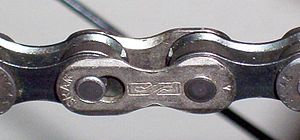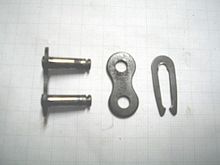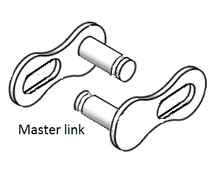- Master link
-
 Figure 3: A SRAM Powerlink, joining two ends of a chain.
Figure 3: A SRAM Powerlink, joining two ends of a chain.
A master link or quick-release link is a bicycle chain accessory that allows convenient removal and reconnection of an installed bicycle chain without the need for a chain tool.[1] It acts as a set of the chain's outer plates, so joining two sets of the chain's inner plate ends. A chain tool is nonetheless needed to adjust a chain's length, for example to shorten a new chain for initial fitting.
Contents
Construction
There are at least two styles of master link. In both cases the master link set consists of two outer plates, each of which resembles the outer plate of a chain.
Straight chainline compatible
In the case of single-speed, hub-geared, or other bicycle bicycle drivetrain systems with straight chainlines or widely spaced sprockets, a style of master link has been available for decades. In this style, one plate has two pins protruding from it, at either end, and the pin ends are grooved. (Refer to Figure 1). Again, the pins are sized to fit the bushings of inner plate ends. The other plate has a pair of matching holes so it can be placed over the pins. Finally, a separate spring clip engages the grooves at the end of the pins to hold the master link together.
External derailleur compatible
For bicycles with derailleur gears, a special kind of master link has been developed to fit closely spaced sprockets. In this case, each plate has a pin protruding from it, at its end, and the pin ends are grooved. (Refer to Figures 2 and 3). These pins are sized to fit the bushings of inner plate ends. In addition to pins each link plate has a tapered slot, one end of which is wide enough to accommodate the end of a pin, the other presenting a tight fit.
The link plates fit together, and connect the chain by feeding their pins through the bushings of the inner plates', from opposite sides. In this way the pair form a loosely interconnected, closed set, with each master link's pin located in the slot of the other, and the two bushings held captive. The connection is then made secure by pulling the chain outwards on both sides of the link. This latter action forces the pin ends into the narrow ends of the slots where they become locked. The overall security of such a master link depends upon the chain being under tension in normal use, though it can fail in extreme conditions where this condition does not hold.
The manufacturers' instructions for the removal of a master link is to press the face of the two plates together, while pressing both ends inward. When a link is new, or when otherwise difficult to remove, master link pliers can be used. The special pliers have curved ends to accommodate the rollers, but provided that the link can be discarded after removal, a conventional chain tool (pin driver) can be used to shear the pins from the plates. Master links can usually be reconnected an indeterminate number of times, though there are some links sold that are to be used once only. In practice, it is found simpler to connect a chain in the lower part of its loop, to make use of the cogs in supporting its weight. Another technique used to stabilize a chain while it is being connected is to tie the two ends together at some distance from the intended connection.
Some links have side plates that are raised on top, while some are straight, and some others have proud pin projections. Since a chain on a derailleur-fitted bicycle is reversed for part of its excursion through the drive-train, and because some cog-sets have close ramp tolerances, such a link could cause a malfunction if the wrong selection were made. Bushingless chains, with smaller projections, are used widely on modern bicycles and where drive dimensions are tight, and in these cases a master link of comparable quality is needed. As a result, some manufacturers of derailleurs recommend only their own products and package a master link with each new chain. Chains for other than derailleur-fitted bicycles are more tolerant of these dimensions.
References
- ^ Sheldon Brown. "Sheldon Brown's Bicycle Glossary: Master Link". http://www.sheldonbrown.com/gloss_m.html#masterlink. Retrieved 2011-06-26.
List of bicycle parts Frame Handlebars · Stem · Head tube · Headset · Fork · Seatpost · Saddle · Bottom bracket · Dropout · Suspension
Wheels Drivetrain Cabling Peripherals Basket · Bell · Bottle cage · Fairing · Cyclocomputer · Kickstand · Lighting · Luggage carrier · Mudguards · Pannier · Saddlebag · Reflectors · Skirt guard · Training wheelsCategories:- Chain drives
- Bicycle parts
Wikimedia Foundation. 2010.


